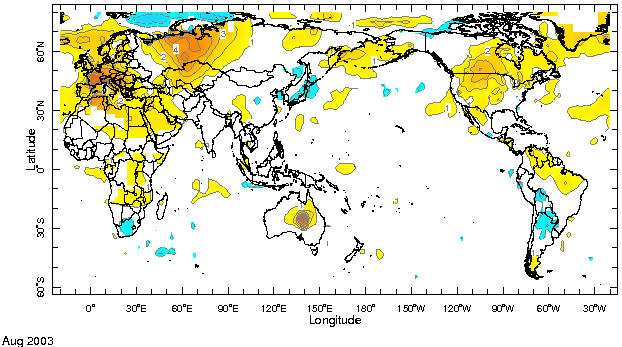|
IRI Climate Digest
September 2003
August Global Climate Summary
Climatological Background
During August, monsoon systems which bring rains to West Africa, South Asia, and southwestern North America reach their northernmost extent. In the Southern Hemisphere midlatitudes, winter conditions begin to wane by month's end.
Monthly Mean Temperature (1961-1990), data from the Climate Research
Unit, University of East Anglia


Monthly Mean Precipitation (1961-1990), data from the Climate Research
Unit, University of East Anglia


Temperatures
Highlights
The ongoing heat wave in south-central Europe peaked during mid-August with numerous record high temperatures set, including an all-time record high temperature in southern England. August brought unusually warm conditions to the west-central former Soviet Union while above-average temperatures were the rule across most of the tropical land areas. Asia: Western Asia experienced warmer-than-normal conditions while Japan continued to be cooler-than-normal.
Africa and Europe: Above-average temperatures persisted across much of Europe and North Africa.
South America: Northeastern South America, along with southern Chile, experienced warmer-than-normal conditions, while cooler-than-normal conditions were felt in areas across central South America.
North America: Much of North America experienced above-average temperatures.
Temperature Difference from the 1961-1990 mean, with data
from NCEP Climate Prediction Center, CAMS.


Precipitation
Highlights
Healthy monsoons brought generally above-average rainfall across the Sahel, India, and central China. Unusually dry conditions continued across south-central Europe and emerged across Java, while the unusually wet summer in the eastern United States continued. Welcomed rainfall fell across much of Australia. Asia: The monsoon in South Asia, which typically reaches its northernmost extent in August, brought precipitation in a pattern similar to that of last month, with above-normal amounts across central India and northeastern Nepal. Japan and central China also continued to have wetter-than-normal conditions, while southern China experienced another month with below-normal precipitation.
Africa: The intertropical convergence zone (ITCZ) continued to lie just north of its climatological position during August. This contributed to the below-normal precipitation along the Guinea Coast and above-normal precipitation in portions of the Sahel.
Europe: The same pattern that maintained the warmth in Europe kept much of the continent drier than normal. Northeastern Europe, however, received above-normal precipitation associated with a weak upper-level trough that persisted in the region during August.
South America: Precipitation was below normal in northern South America and southern Brazil and above normal in Ecuador and northern Peru.
North America: Central North America experienced drier-than-normal conditions while southeastern North America continued to be wetter than normal.
Precipitation Difference from 1961-1990 mean, with data
from NCEP Climate Prediction Center, CAMS-OPI.


Oceanic Conditions
Tropical Pacific: Sea surface temperatures in the far eastern equatorial Pacific warmed during August and are currently only slightly below average. Temperatures in the central equatorial Pacific are near average while somewhat above normal to the west. See the latest IRI ENSO Update for a detailed summary and outlook.
Tropical Atlantic: SST conditions changed little from July to August. The SSTs off the west coast of Africa from 20°S to the equator remained above normal, and the area of above-normal temperatures in the northern tropical Atlantic expanded in August.
Indian Ocean: The above-average sea surface temperatures extending from the Arabian Sea to the central Indian Ocean remained largely unchanged from July to August. The below-normal SSTs to the south of Sumatra and Java weakened slightly.
Mid-latitudes: The area of above-normal SSTs east of New Zealand shrank in extent between July and August. SSTs remained generally cooler than normal in much of the southern latitudes of the Indian Ocean. Water temperatures remained well below normal around the Japanese Islands and Korean Peninsula again in August, and the below-normal temperatures in the central northern Atlantic Ocean weakened considerably. Temperatures in much of the rest of the North Atlantic and the Mediterranean remained above-normal.
Monthly Sea Surface Temperature Difference from the 1971-2000 mean,
with data from the Environmental Modeling Center, NCEP/NOAA.


Contents |
Special |
Impacts |
Climate |
Forecast
| 
